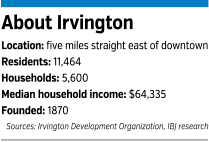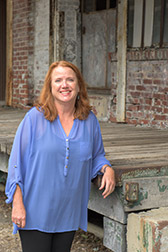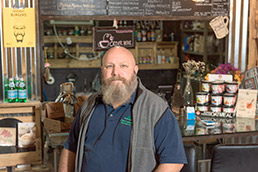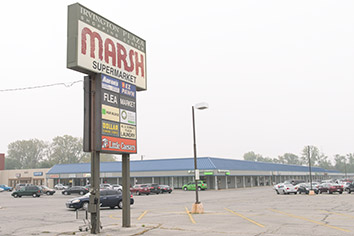Subscriber Benefit
As a subscriber you can listen to articles at work, in the car, or while you work out. Subscribe NowHad you stood at the corner of Audubon Road and Bonna Avenue one rainy day in April 1865, you’d have been in mourning.
On this spot, at mile marker 183 of the Pennsylvania Railroad, residents of what would become Irvington beheld the arrival of the funeral train carrying President Abraham Lincoln.
Today, this ground five miles straight east of downtown—still consecrated by the mile marker—is evoking hope, thanks to a rebirth of commercial development in Irvington, which was founded in 1870 as one of Indianapolis’ first suburbs.
 For decades, commercial growth failed to keep up as young professionals flocked to Irvington, drawn in part by the affordable-yet-architecturally significant homes built in the late 19th and early 20th centuries. Developers instead focused their efforts on newer and larger suburbs ringing the city.
For decades, commercial growth failed to keep up as young professionals flocked to Irvington, drawn in part by the affordable-yet-architecturally significant homes built in the late 19th and early 20th centuries. Developers instead focused their efforts on newer and larger suburbs ringing the city.
But that’s changing, in part because of grass-roots efforts by local residents, as well as attractive demographics. The median household income in Irvington is $64,335, well above the median for Marion County of $42,000.
The latest commercial success: ExactTarget co-founder and entrepreneur Chris Baggott recently bought a strip center on the site of the former Irvington town hall, a stone’s throw from where Lincoln’s train passed.
Baggott plans to add to the site a Mug restaurant—his second Mug since launching the restaurant in Greenfield last year. When it opens next spring, Irvington’s Mug will serve meat from pasture-raised animals at Baggott’s Tyner Pond Farm in Hancock County.
“We’re not exactly sure what the layout and look and feel will be like,” said Baggott, a former Irvington resident, whose eclectic interests range from information technology to farming.
 Margaret Lawrence Banning, executive director of the Irvington Development Organization, said the Coal Factory project will propel the neighborhood into a “new era.” (IBJ photo/Eric Learned)
Margaret Lawrence Banning, executive director of the Irvington Development Organization, said the Coal Factory project will propel the neighborhood into a “new era.” (IBJ photo/Eric Learned)Added Margaret Lawrence Banning, executive director of the Irvington Development Organization: “Just to have someone of his caliber invest here is very exciting.”
Big ambitions
An even bigger project is in the works south of Washington Street, just a few blocks from the Indianapolis Marion County Public Library branch—an area that once was Irvington’s downtown.
Last year, IDO snagged a $500,000 grant from the city to jump-start redevelopment of a site a block away that had been Irvington’s former coal depot, at Bonna and Ritter avenues.
The 50,000-square-foot Coal Factory project, estimated to cost nearly $2.5 million, will involve remodeling and expanding existing buildings to accommodate additional tenants, including an expansion of Black Acre Brewing Co., whose restaurant is on Washington Street.
Other possible tenants include a mix of restaurants, retail, artisan food production, entertainment offerings, and users of shared office space.
“We feel like this has been a decade in the making. When this site takes off, this will really be a new era,” Banning said.
Irvington’s commercial comeback has been driven in part by local entrepreneurs with a passion for the neighborhood.
There’s Justin Miller, co-owner of Black Acre. He’s heading Irvington Brewing Real Estate LLC, which is seeking investors and renovating and leasing the Coal Factory.
Also committed to Irvington are natives Kevin and Annette Mandrell, who were so attached to IPS School 85, at 338 S. Arlington Ave., that they bought it after IPS shuttered it in 1997. The school, where Dwight Eisenhower once gave a speech during one of his presidential campaigns, now houses about 20 businesses as Irvington Office Center.
Even Baggott attributes his affinity to Irvington for his decision to invest there. “I love Irvington. I always have.”
And then there are intrepid souls like David Jackson.
 David Jackson owns Coal Yard Coffee and has big plans for a property he recently bought that includes a 102-year-old ice house. (IBJ photo/Eric Learned)
David Jackson owns Coal Yard Coffee and has big plans for a property he recently bought that includes a 102-year-old ice house. (IBJ photo/Eric Learned)The stocky Marine Corps veteran sporting a gray beard and wide grin recently bought a property in the 400 block of south Ritter, within sight of the closed Navistar foundry. The three buildings on the site include an ice house built in 1913.
With a towering ceiling held up by iron trusses like something out of a Civil War-era warehouse, it screams to be an event destination. The loading ramp for ice blocks is a ready-made stage. Other parts of the building would make for charming restaurants. There’s even an attached tower.
It reeks of musty smells but even more of history.
“I haven’t got it all worked out in my head yet,” Jackson said of reuse possibilities.
He has a clearer vision for a former horse barn next door. It was home to horses and wagons that delivered ice. Jackson gestures to the faint outlines of numbers painted on the brick walls that designate stalls.
The long, brick building could accommodate several shops connected by a single hallway, which would allow would-be shoppers to go store to store without stepping outside in bad weather. Jackson has talked to a coffee roaster and even persuaded an antique furniture business to decorate one of the spaces to help prospective tenants visualize the possibilities.
One promising tenant in his mind would be a grocer. “I lived in Japan. There’s a grocery store on every corner,” Jackson said.
Challenges loom
Repurposing such Irvington sites isn’t for the faint of heart.
Jackson told Banning he recently cleared a regulatory hurdle toward having his property deemed not to be a brownfield site.
“Yea, David!” Banning responded, clapping her hands.
Another challenge in Irvington can be parking. Jackson figures he’s beaten that problem, having discovered a large concrete pad out back, in what appeared to have been part of a loading area for a railroad spur.
Making the most of buildings that at first don’t seem appropriate for reuse is another must. One needs a good imagination.
Take Jackson’s Coal Yard Coffee, which faces out onto the newly extended Pennsy Trail, along Bonna Avenue. The cafe is in an old, concrete-block outbuilding on the Coal Factory site. Its garage door has become the front door—a big, inviting one. Inside is funky furniture, interior walls decorated with corrugated metal panels, and touches such as tree branches sawed into discs that make for cool ceiling decorations.
Jackson also adorned the place with paintings from local artists, with price tags affixed, should customers want to take one home. Bands play regularly and pets sometimes wander in. The place attracts millennials like a porchlight draws moths.
Redevelopment, particularly in Irvington’s old downtown, also requires patience.
In recent weeks, just outside the door of the coffee shop, the city began rebuilding Bonna Avenue and will add 40 parking spaces. Just weeks earlier, the smell of asphalt wafted into the cafe as workers applied asphalt over the former Pennsylvania Railroad corridor. The city extended the Pennsy Trail along Bonna to Ritter Avenue from Arlington Avenue, then north up Ritter to Ellenberger Park.
More transportation links might be coming over the next decade. IndyGo intends to establish a bus rapid-transit line down Washington Street and through Irvington.
“That will be another incredible asset,” Banning said.
Another lure for further development will be additional streetscape improvements, such as streetlights and planting beds. Recently, workers wrapped up $1.5 million in such upgrades; another $1.5 million in work is planned for next year.
Critical mass needed
Finding new uses for individual properties is one thing; a commercial remake of an entire community long-ago bypassed for farther-flung suburbs is another.
It’s been a long time since Irvington was considered the next up-and-coming suburb—not since about 1870.
Two lawyers from eastern Indiana—Jacob Julian and Sylvester Johnson, started out buying more than 300 acres of land in what would become Irvington. They saw Irvington as an investment opportunity, not unlike how developers today might conjure up an Anson or other planned urban development sporting residential and retail.
Julian built a home along Audubon, as did his brother George Julian, a U.S. senator credited with writing the 15th amendment, which granted African-Americans the right to vote. George’s house at 115 S. Audubon remains.
Irvington was home to Butler University until the late 1920s, when Butler moved to 46th Street, along the White River.
Its neighborhoods remained relatively stable, though, and commercial development shifted toward Washington Street. To the chagrin of residents today, workers razed many of the older, architecturally significant buildings along Washington over the years in favor of more modern but arguably schlocky storefronts.
When many of those retailers later moved east to places like Shadeland Avenue, “we kind of got left behind with these not terribly attractive buildings,” Banning said.
“We have to create more of a critical mass for people to come to Irvington,” she said.
Indeed, Irvington faces commercial development challenges that some older neighborhoods don’t—such as Fountain Square, southeast of downtown.
On one hand, both are vintage neighborhoods experiencing a surge in property values and attracting younger professionals, said Irvington resident and real estate agent Deb Kent.
On the other hand, whereas Fountain Square “has finally caught up to its economic core, Irvington is the other way around. Business is lagging behind a strong residential core characterized by diversity, interesting street design [and] bigger and relatively affordable properties,” Kent said.
Slowly but surely
Commercial redevelopment has been slow, but success is measurable.
Over the last few years, nearly three dozen businesses have moved in. In 2013, the Irvington Development Organization and a private developer demolished the crime-ridden Indy East Motel on Washington Street, and replaced it with Irvington Lofts, an $11 million affordable-housing project with 50 apartments. With a facade of contrasting rectangular panels, Lofts is the boldest change to Washington Street in years.
Banning said the lofts project has had a positive effect on other commercial properties. She puts her arm out her car window and points to a nearby apartment being renovated. A little farther west, at Washington and Ritter, is an empty lot that once housed Irvington’s post office. IDO and the Irvington Historical Society owned the building and were trying to rehabilitate it when it blew down in a 2013 storm.
The city would likely permit construction of a three-story building, with retail on the lower floor. The downside is that there’s not much in the way of dedicated parking spaces. So the thinking now is that the site might be perfect for a high-end restaurant. People are often willing to walk a little bit to such an attraction, Banning said.
Irvington leaders are confident the neighborhood can attract such businesses, based on the town’s robust professional class, which has incomes far higher than elsewhere on the east side.
“What investors need to understand about this community is that residents have money to spend. And some are driving north or south, to Greenwood, to spend it, at places like Trader Joe’s, Whole Foods and Nordstrom’s,” Kent added.
While Irvington in many ways is an island amid an ocean of more modest income, it is a fairly compact island of about one mile in each direction—versus the five-mile patch many major retailers look for in terms of a promising market.
Yet shifting demographics in Irvington may ratchet up developers’ interest.
Longtime Irvington-area resident Phil Kenney, president of F.A. Wilhelm Construction Co., said he’s observed a steady rise in families with children. Suburban flight took its toll here, as in many parts of Indianapolis, with school desegregation in the 1960s. However, a number of charter schools have popped up in the area, along with parochial-school options. Five of Kenney’s children attended nearby Our Lady of Lourdes school, for example.
“I think there is a sustained development, and it’s been going on for the last few years as shops on Washington Street have been remodeled and new businesses have gone in,” Kenney said.
Those setting up shop on Washington Street include several locally owned eateries, such as The Legend Cafe and Jockamo Upper Crust Pizza.
Next on agenda
If there’s a proverbial elephant in the room regarding Irvington’s attempts to grow its commercial base it would be Irvington Plaza, at 6415 E. Washington St.
The 1950s-era plaza has a Marsh grocery, a Dairy Queen, a new health clinic and a patch of partly occupied strip-mall buildings painted a drab gray. The plaza is fronted by an enormous, unsightly parking lot.
“This is our next challenge,” said Banning, steering her car into the plaza and making the long drive to the back, past a flea market, to an ornate rock garden built by neighbors in Irvington Terrace. Pennsy Trail also runs behind the plaza.
A more appropriate use of the Irvington Plaza land would be to construct retail buildings closer to Washington Street, making them more walkable, she said.
That would free up space to the south, near the Pennsy Trail, for additional housing—perhaps including multifamily units, says IDO.
Of course, such changes would require the plaza’s owner to agree to such a concept.
“We’ve had one nibble [from a developer], but they just couldn’t come to an agreement with the owner or existing tenants,” Banning said.
Nobody is ready to give up, though.
“The potential for business is in the ailing or abandoned shopping centers and big-box stores [such as] Kmart, Irvington Plaza—vast expanses of empty parking lots and strip malls that are prime real estate and ripe for mixed-use development,” said real estate agent Kent.
She said Pennsy Trail could become the next Monon Trail “in terms of attracting new businesses and housing.”
Living and working in Irvington, Kent said she’s seen property values rise steadily over the last five years, with some homes now selling in the high $200,000s and above, “which means there’s real opportunity here for economic development.”•
Please enable JavaScript to view this content.

